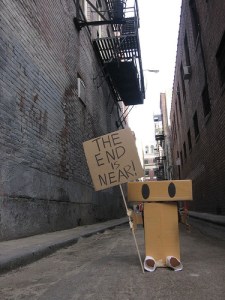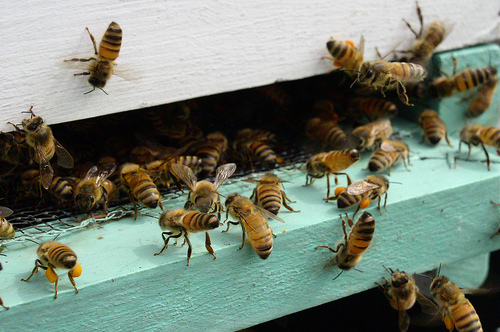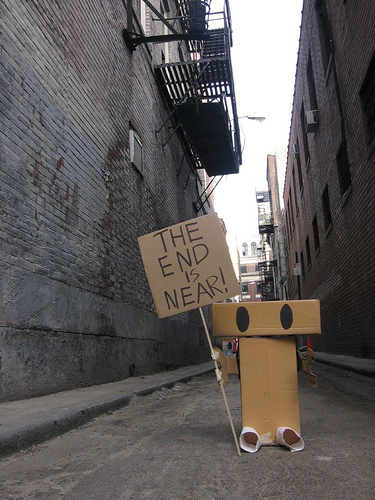
Photo by Larry West.
Developer Larry Hall has a grand plan for four nuclear-missile silos in Kansas. He’s transforming them into impenetrable, bunker-like “condo” complexes for wealthy survivalists — a haven behind nine-foot-thick concrete walls when the country is reeling from a rampant virus, a terrorist attack, an electrical-grid failure, or maybe just an off-the-charts balmy April. You can get a piece of this paradise for anywhere from $1 million to $2 million, according to news reports about his project. Hall already has four buyers, and prospective clients in NFL players, movie producers, and politicians. And he’s reserving a unit for himself — his personal getaway, some 400 miles from his home in Denver.
It’s subterranean living at its finest, in the ultimate gated community.
America is in an apocalyptic mood, and maybe for good reason: Climate change looms as a major threat, gasoline is pushing $4 a gallon, ecosystems are collapsing, and the country is fractured politically, socially, and economically. Even our most popular entertainment — like The Hunger Games, The Road, or The Walking Dead — is downright gloomy. If you spend any time on sites like Michael Ruppert’s Collapse Network, you’ll find folks talking about setting up “lifeboats” — places with food supplies, water, and arable land to aid survival when the shit hits. Hall’s bunker condos are merely a more drastic form.
Let’s take a grim view and assume for a moment that the world is indeed going to hell in a handbasket. Is Hall’s bunker building the appropriate response? Or is it misguided — even dangerous?
First, there are some basic logistical questions to consider: In a sudden emergency, how would Hall and his clients get to their remote silo condos? (You’d think that the wealthy would be the first targets in that kind of crisis.) The roads would be congested with others trying to run to the hills — and fraught with danger. (The zombie hordes would drag them out of their cars and eat their brains.) Certainly, they are rich enough to afford private helicopters or planes — but they’d still have to get to the airport.
And what about sustaining life down there? The complexes will reportedly come with stockpiles of food and water, indoor farms, pools, movie theaters, libraries, medical centers, and schools. The stories say that the complexes may run on “windmill power,” but wouldn’t the mobs on the surface dismantle those turbines and take them to their own communities? Perhaps Hall has worked out those details. I suspect it has something to do with the barbed-wire fences and “elaborate security system and staff” alluded to in the article.
But more important, we should consider what Hall’s silos represent: His clients — undoubtedly some of the most influential people in their respective communities — are essentially checking out.
Andrew Szasz, a sociologist from the University of California at Santa Cruz, noted this trend in his book Shopping Our Way to Safety: How We Changed from Protecting the Environment to Protecting Ourselves. Americans, he observes, increasingly believe that if they buy things like bottled water, duct tape for sealing windows, sunscreen, and organic food, they can insulate themselves from threats in society and the environment. The problem is that this “inverted quarantine” provides a false sense of security, and it doesn’t help people address problems that are best tackled collectively. Slowing climate change, addressing peak oil, equalizing the distribution of wealth, halting the demise of ecosystems, building mass transit, mitigating the downsides of agribusiness, or, hell, just getting clean water out of the tap — all are major challenges that require societal or governmental coordination.
It’s about community, stupid.
“Inverted quarantine is implicitly based on denial of complexity and interdependence,” Szasz writes. “It mistakenly reduces the question of an individual’s well-being to nothing more than the maintenance of the integrity of the individual’s body … What good does it do to encase one’s body in a toxics-free bubble when things are falling apart so completely?”
Unfortunately, this seems to be the way things are going. A kind of hyperindividualism dominates one chunk of the political spectrum, with sympathies in others. So we see a retreat on environmental protections, support for infrastructure, funding for schools and colleges, and other collective actions that have made this country great.
Suburbanization, Szasz argues, was a form of inverted quarantine, with far-reaching effects. Those who could afford to check out of the cities did so, disinvestment and deterioration followed, and now the plight of cities are a major burden for the country. For his book, Szasz also studied the bomb shelters of the Cold War era — an extreme version of inverted quarantine, much like Hall’s doomsday silos. Concerned scientists of the era argued that bunker-building would “foster a ‘false sense of security’ that would make atomic war seem more acceptable” and would in turn encourage statesmen “to take a hard line in foreign policy, to take larger risks, to go to the brink.”
Of course, in the end, the Cold War bunker builders had to consider what kind of world they would return to, after their two-week food supply ran out: a blackened, poisoned environment. Hall’s silo dwellers might be able to stay underground longer — he says the dry goods would last five years — but they would eventually have to come up. These elites might emerge into a world where the terms of wealth have completely changed — where people value not currency but connections, land, and skills: how to grow food, weave textiles, weld metal, fix engines, make medicines, and so on. And the world would have gone on without the silo dwellers for so long, the surface dwellers might not need — or want — to see their return.
For most of us, it’s a moot topic. I could never afford one of Hall’s condos, and I might not be welcome anyway. Think about what life would be like down there — to be locked up with a bunch of people so rich, so disengaged, and so eccentric that they bought a piece of a nuclear silo to live in, while the world burns.
Frankly, I’d rather throw in my lot with the rest of humanity, still stuck in the real world above.



